Medical Software Development: Benefits and Implementation Strategy
10 Sep 2020
12 Min
2845 Views
The worldwide healthcare system is passing a huge workflow transformation. More hospitals and medical facilities are stepping on a digital healthcare path every year.
For example, Statista took a survey and discovered that 100% of physicians from the UK use EMRs in their practice. Other countries are not too far from that number.
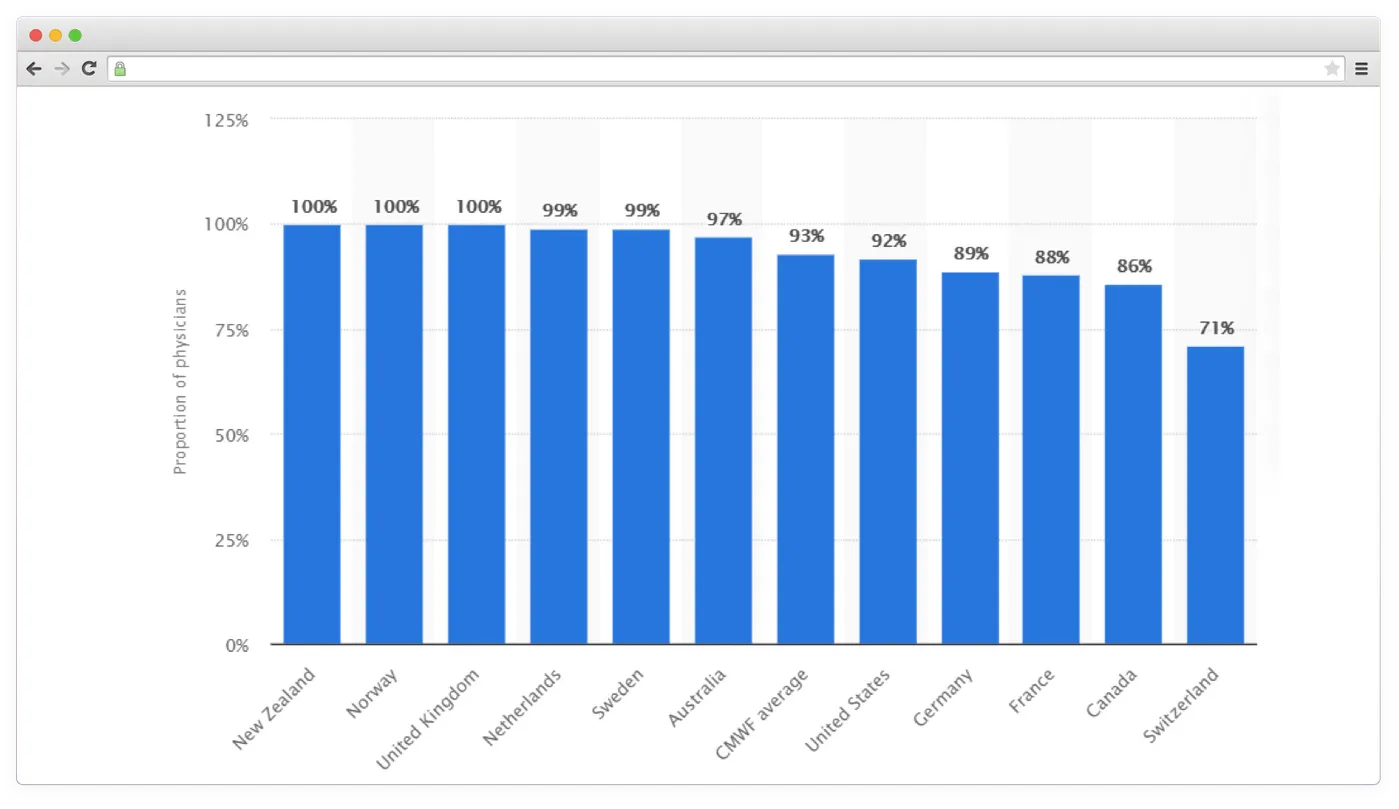
Number of physicians who use EMRs in their practice (Source: Statista)
Here’s another example of medical software development success. Analysts forecast that the market size of the medical imaging analytics software will exceed $4.2 billion by 2025.
In this article, we’ll dive into the medical software development field and cover such aspects as types of software, their benefits, and ways to approach the development.
Types of Medical Software
The definition of medical software is slightly blurry. In simple terms, medical software is any kind of software utilized within the healthcare system (developed during a healthcare web development or another type of medical solution building).
But there are many types of medical software both for physicians and patients. Underneath, you see a list of the most popular and frequently used business solutions.
Business-Centric Solutions
This medical software development type is aimed to make the workflow of medical facilities and physicians more comfortable and fluent. There are several medical software solutions related to this type.
EHR Software
This software is a digital database with patients’ medical histories and other vital information about them. EHR is the most popular type of software in the healthcare field since it reduces the amount of paperwork.
EHRs typically come with the following features:
- Health information storage and management
- Patient support (tools for constant access to health records, interactive education)
- Medical examination result management,
- Decision-making support for physicians (alerts for possible drug-drug incopatibility, patient-specific recommendations based on patients history)
- Appointment scheduling
The most well-known out-of-the-box EHRs are DrChrono EHR, Kareo Clinical EHR and MediTouch.
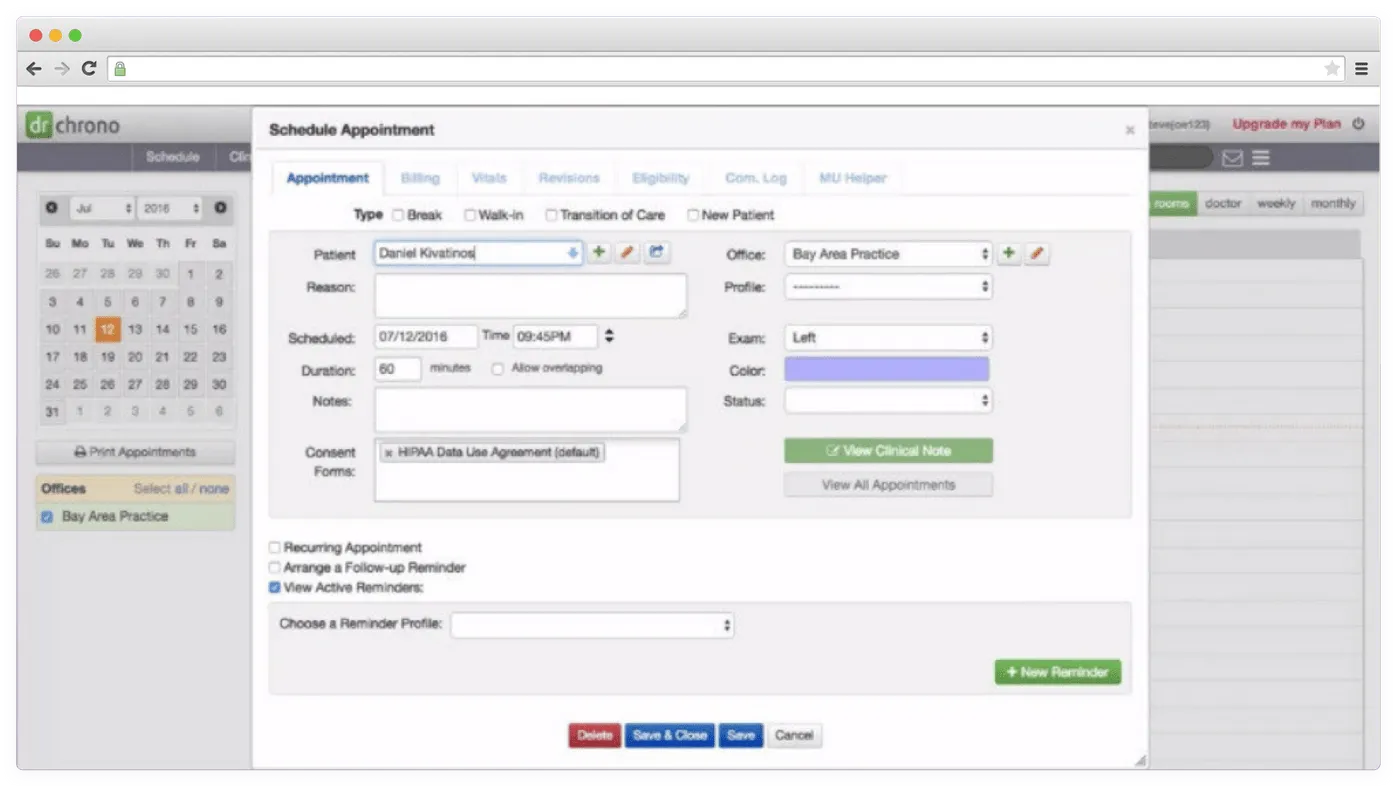
DrChrono appointment scheduling (Source: EHR in Practice)
CRM software
Healthcare CRM software development is a win solution for medical organizations. It makes it possible to derive data from multiple locations and transform it into a powerful instrument for business analysis. Using such a digital solution, you’ll be able to evaluate expenses, KPIs, and patient satisfaction scores, as well as assess the ROI of marketing campaigns to engage new patients.
Medical CRMs typically include the following modules (features):
- Business management module
- Data management module
- Sales & marketing functions
- Analytic module
Medical Database
This database stores and organizes all clinical cases. The main goal of these databases is to improve the decision-making process. Physicians can search through the database to find similar records and treatment procedures.
To make the search process more convenient, databases must have powerful tools for working with data (filter options, simple and informative data visualization). Moreover, data sharing and backup options are a must.
Medical Imaging Software
Medical imaging software is designed to process, visualize, and manage x-ray, MRI, and CT scans. Besides, this software can also create anatomical models for surgical planning.
Medical imaging software development requires adding special features depending on the healthcare area where they’re used.
For example, dental imaging software can have various volumetric visualizations of the jaw that can be viewed from all sides and corrected in real-time. They often come with various functions of drawing on top of the 3D model, adjustable gamma and color of the picture for detailed healthcare data visualization.
The best examples of the medical imaging software are Arterys, Aidoc, OsiriX DICOM Viewer.
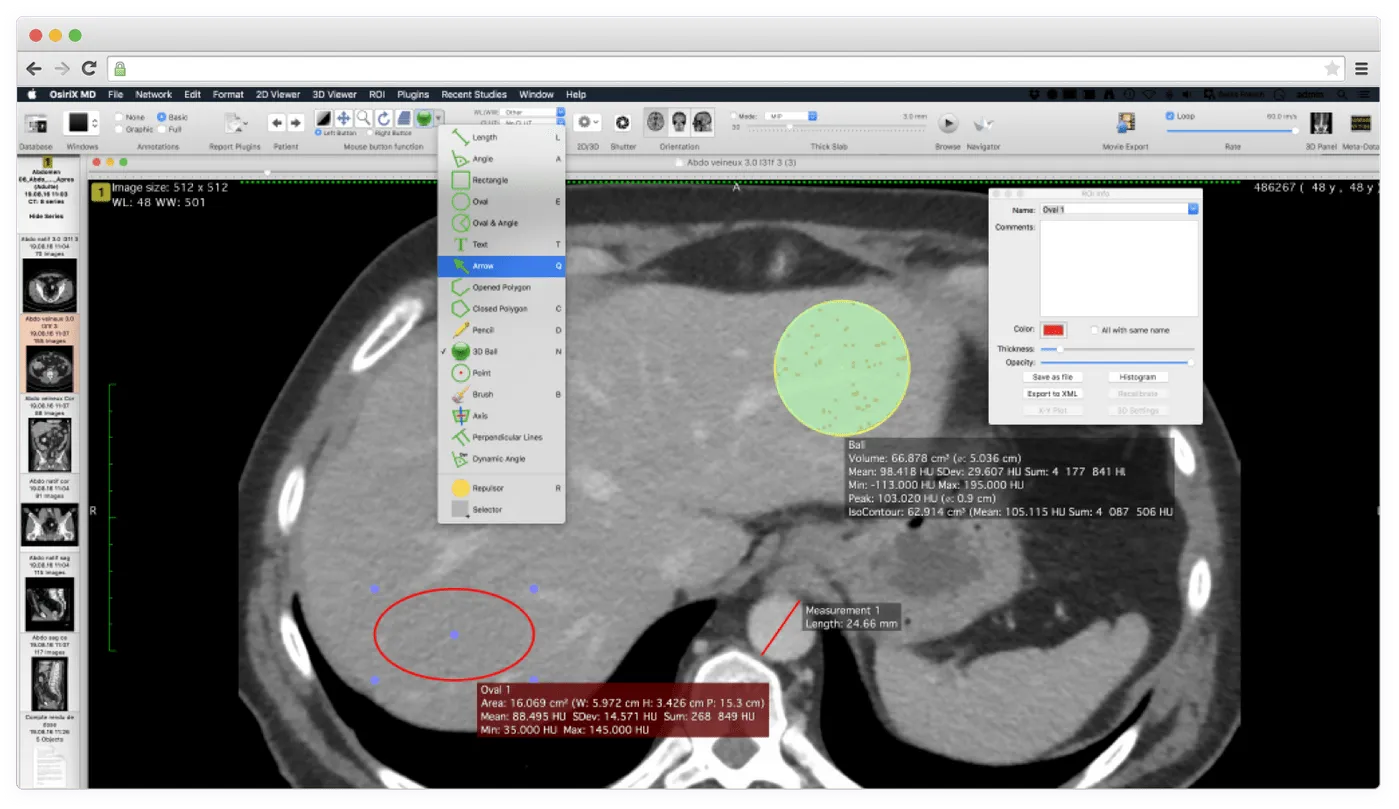
OsiriX DICOM Viewer interface (Source: OsiriX Viewer)
Medical Billing Software
Medical billing software is designed for accounting departments in hospitals. By incorporating medical billing software development, accountants get an opportunity to manage and track all financial operations within the facility:
- Invoicing
- Insurance claims
- Patient’s eligibility verification
- Superbills management
This software is usually a part of bigger systems like EHRs. There are a few standalone billing software like Kareo, Collaborate MD and Medical Billing Solutions.
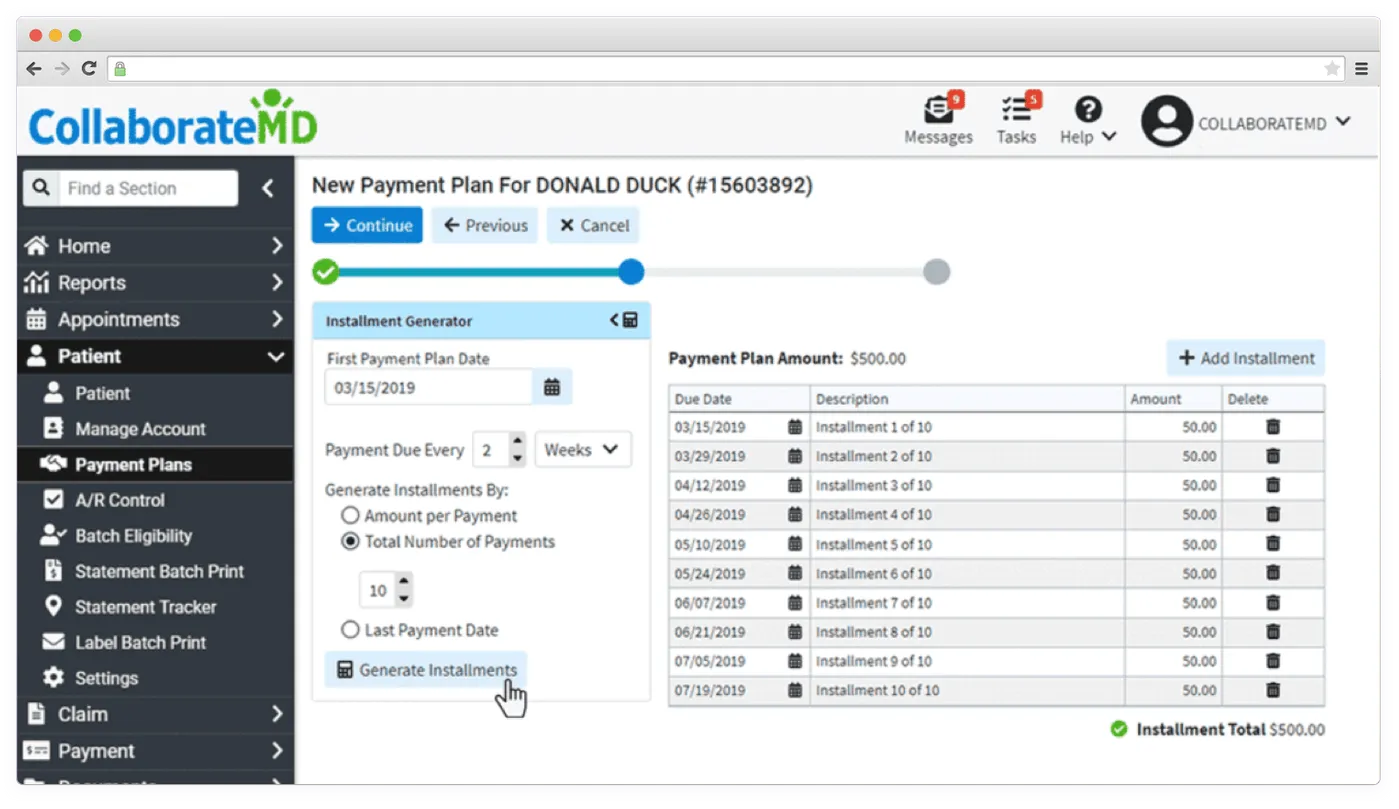
ColaborateMD interface (Source: SoftwareConnect)
Hospital Management Software
Hospital management software development is intended for maintaining everyday hospital tasks that affect overall service quality:
- Bed and inventory management
- Staff and physician control
- Claims management
- Medication stock management
This type of software is often integrated within EHR systems. The most powerful hospital management solutions are eHealthFlex and eHospital Systems.
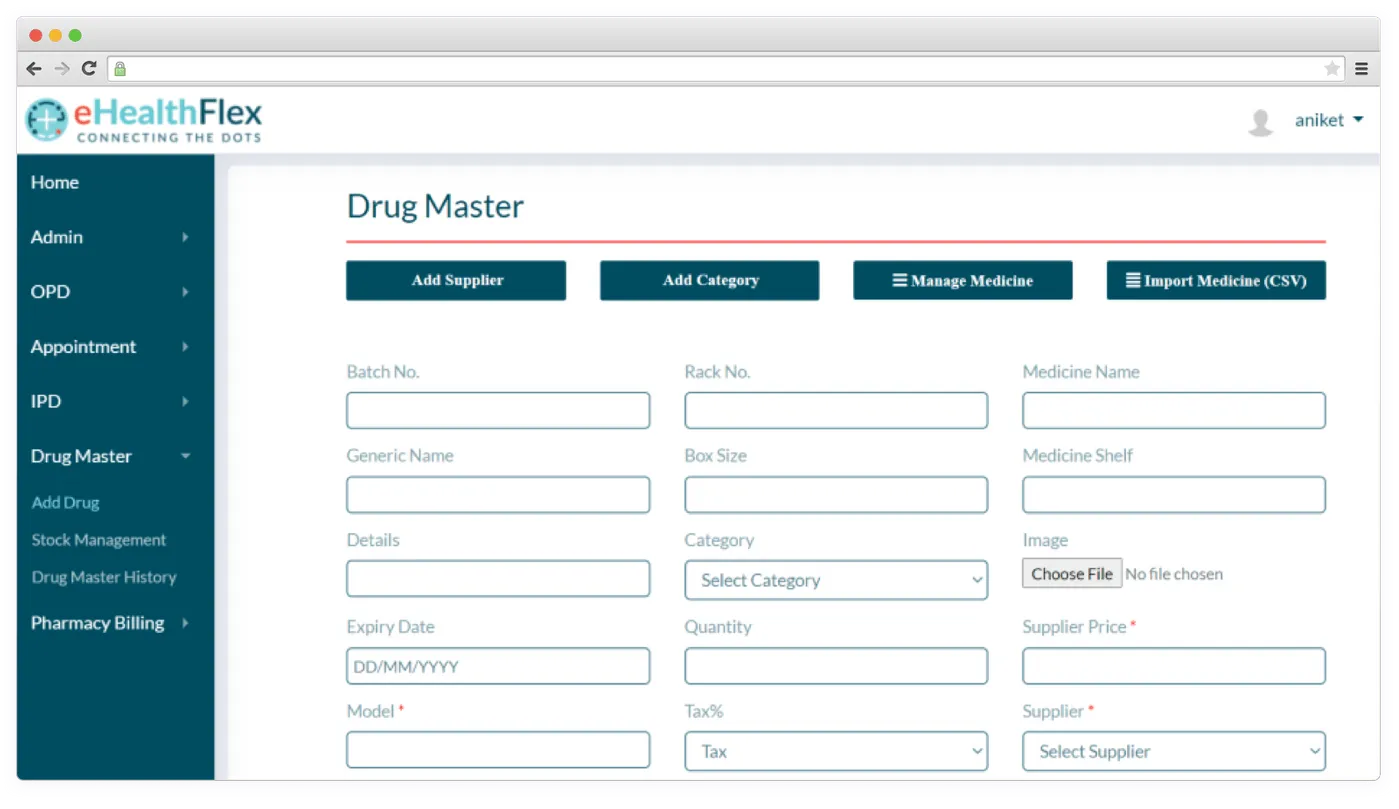
eHealthFlex medication management (Source: Capterra)
Patient-Centric Solutions
This medical software development type aims to make the interaction between patients and hospitals smoother. Moreover, it reduces the number of confusions that patients may face: storing medical records, waiting in long lines, scheduling appointments, and so on.
There are several examples of patient-centric software.
E-prescribing Software
E-prescribing helps physicians to precisely control medication prescriptions for their patients. Physicians can track and manage dosage, add or remove drugs from the list, or completely cancel prescriptions.
Besides, this type of software reduces the number of medication errors like adverse drug events (ADEs) and improves the overall decision-making process.
DrFirst made a calculation and found out that e-prescribing software increased medication adherence by 11%. The most popular e-prescribing solutions are ScriptSure, iPrescribe and Rcopia.
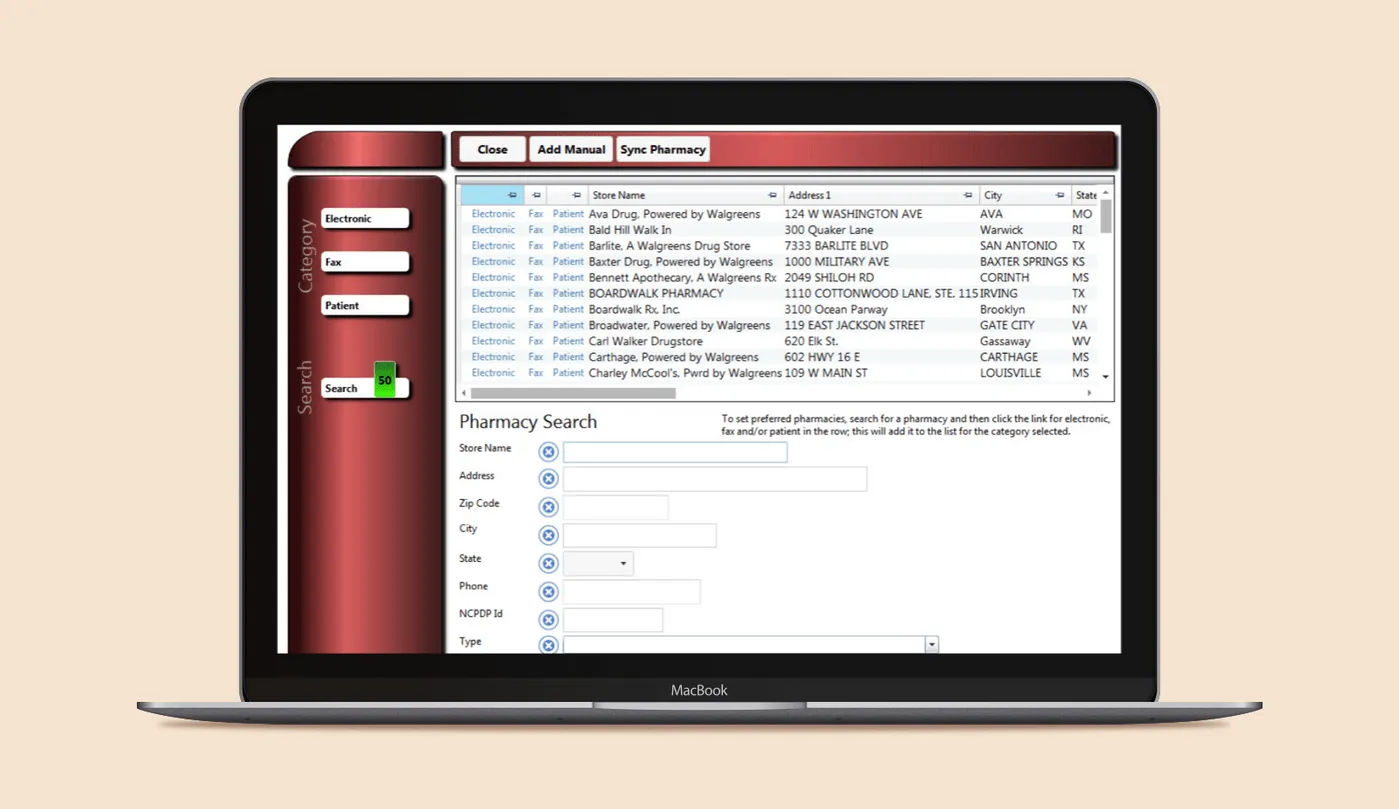
ScriptSure interface (Source: Daw Systems)
Telemedicine Software
Telemedicine’s main goal is to bring physician appointments online. Telemedicine is on its rise now, and Statista forecasts that the telemedicine market size will exceed $41 billion by 2026. This forecast shows the overall convenience of telemedicine both for physicians and patients.
Telemedicine software should bring various communication methods to users (chat, calls, video sessions) to fulfill its main goal properly. Besides, telemedicine solutions should have two versions (web and mobile) to make video sessions and calls more convenient.
Wondering how much does it cost to make a telemedicine app? Discover precise numbers in our article.
Among out-of-the-box telemedicine software examples are Mend, Doxy.me and AMC Health.
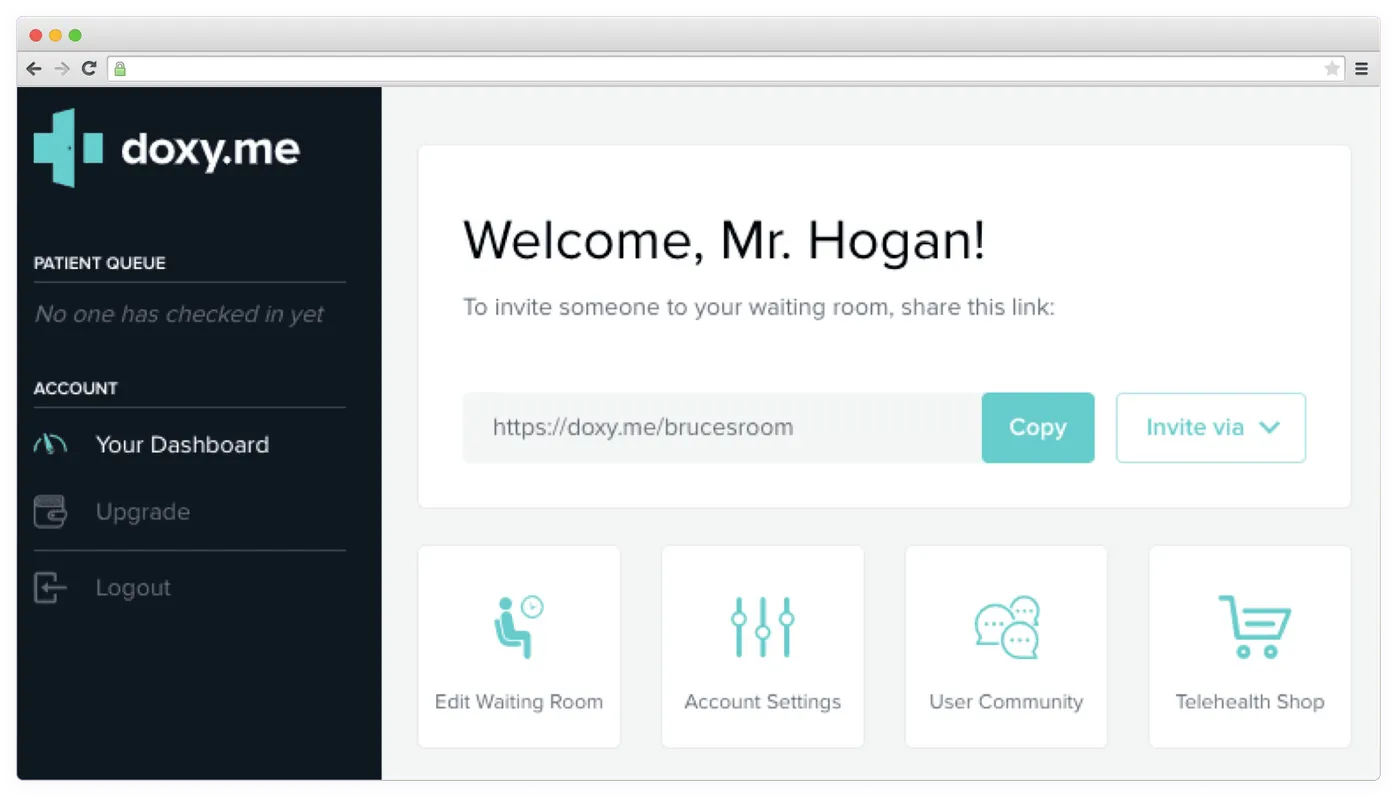
Doxy.me dashboard (Source: TechnologyAdvice)
Appointment Booking Software
Appointment booking software is another example of a popular medical software type. It reduces the waiting time in lines for patients and increases working efficiency for physicians.
Usually, this system consists of a schedule panel and a patient app. Physicians can make an appointment through the schedule panel. In turn, patients will get a notification about this event on their mobile devices with the installed app.
The best examples of this software are Appointment Plus, Appointy and DocMeIn.
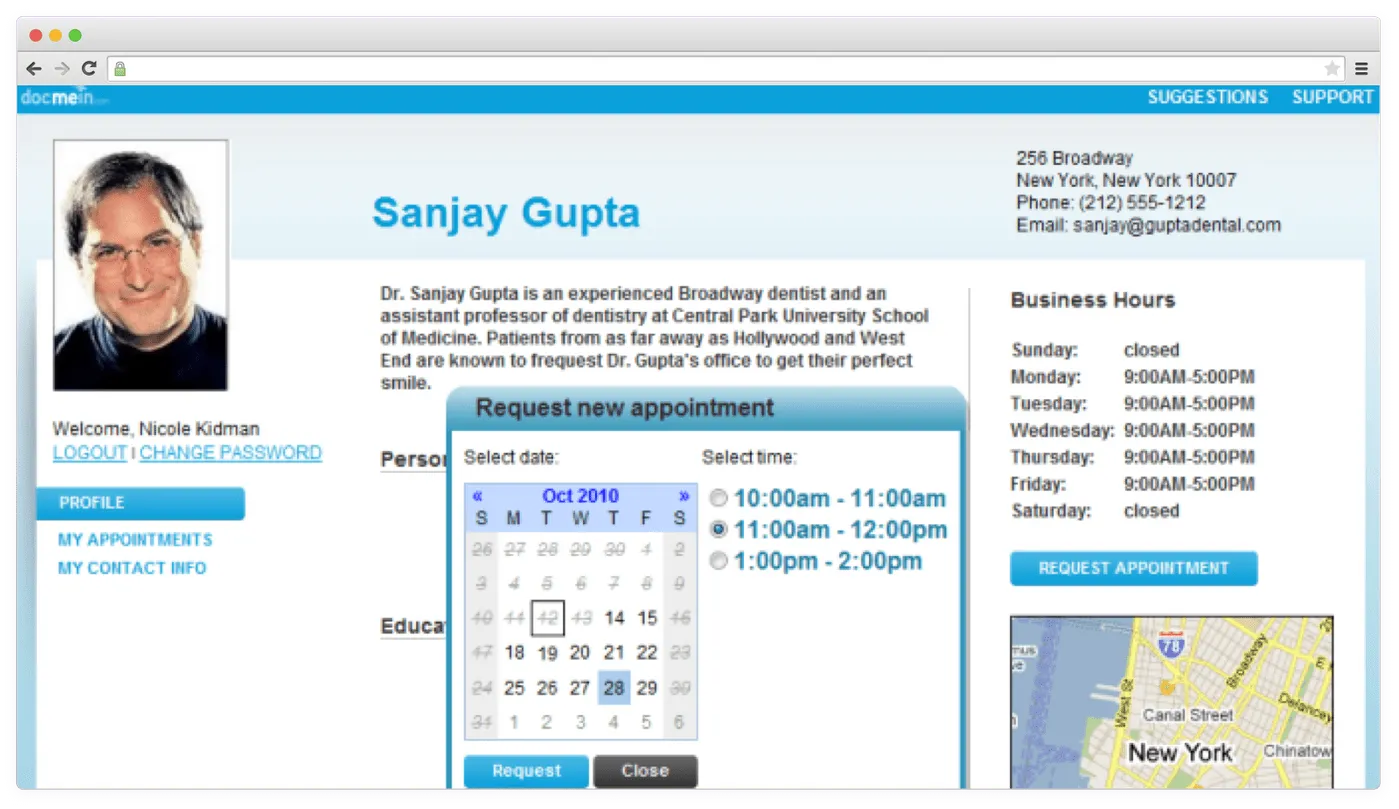
DocMeIn interface (Source: DocMeIn)
When Medical Organizations Need Custom Medical Software?
Even though we’ve listed lots of pre-made medical solutions, they have their own flaws. Out-of-the-box software can’t cover all possible use cases. It often lacks specific features that some hospitals may require: integration with existing custom software, special approach to patient data processing, or uncommon report generation.
In addition, pre-made software tends to meet as many needs as possible to cover a broader audience. This leads to overloaded interfaces and redundant features for some medical facilities. Complicated interfaces can negatively impact the staff training time and lead to human mistakes during the working process.
Custom medical software development lets you create unique solutions that’ll be designed for a specific medical facility, taking into account its unique workflow.
Since custom solutions fit perfectly into the hospitals’ existing workflows, such software is much more efficient and convenient than ready-made solutions.
Wondering about hospital app development? Learn the reasons why they prevail over off-the-shelf solutions.
Let’s take a look at the benefits of using such software for all participants in the healthcare system: physicians, patients, and medical facilities.
Benefits for Doctors
- Less monotonous paperwork.
- Physicians can manage a large number of patients using e-health records stored in databases.
- Cooperation convenience among other physicians goes to a new level, thanks to telemedicine.
Benefits for Patients
- Appointments can be scheduled fast and easy.
- Telemedicine makes communication between physicians and patients much more comfortable. No more waiting in long lines.
- E-health records grant convenient access to all medical examination results and medical history of the patient.
- Various medical education resources provide useful information across multiple healthcare fields.
Benefits for Medical Facilities
- Process management within the facility becomes much more fluent and efficient.
- Communication tools make the cooperation of physicians easier and not tied to the specific location.
- Automation of various tasks reduces operational costs.
- Overall level of customer service increases, which leads to better patient satisfaction.
If a medical organization strives to receive these benefits and provide better services, it’s a perfect time to think about outsourcing medical software development. This approach enbale healthcare providers to receive diverse, unique, and high-level assistance for comparatevely lower costs and better scalability options range.
How to Approach Medical Software Development?
If you want to digitize your medical facility, you can use ready-made solutions. But what should you do if the ready-made solution isn’t flexible enough and doesn’t fit the existing business? In this case, custom medical software development comes to the rescue.
But it’s worth noting that this is a rather complicated and long process. Even creating an appointment booking software will not work out of the blue. And if you plan medical device software development, it may require even more time and expertise.
Let’s get you on the right side of medical software development.
Step 1. Define the Audience Which App Is Aimed for
The target audience is the cornerstone on which the future development process should be based. The audience and their needs will determine what features will be included to the software and what tasks it will fulfill.
You must conduct an in-depth analysis of your target audience (be it employees or patients) to find out what they want to see in the product you’re going to introduce. It’s also important to analyze out-of-the-box software and their reviews. User reviews can provide valuable insight into what they have done well and what features they lack. Probably, you’ve used a ready-made solution on your own and have some background to analyze.
This analysis will also help your development partner to determine the approximate tech stack for the product: integration with the cloud or the use of the Internet of Things.
Want to learn more about IoT in healthcare? Discover their benefits and use cases in healthcare.
Step 2. Work Out Functional Structure of the App
Designing the future medical software structure is the next step. With a list of functions in hand, you can combine them into different modules and define how they’re going to be connected to each other. In the picture below, you can see the structure of the hospital management system.
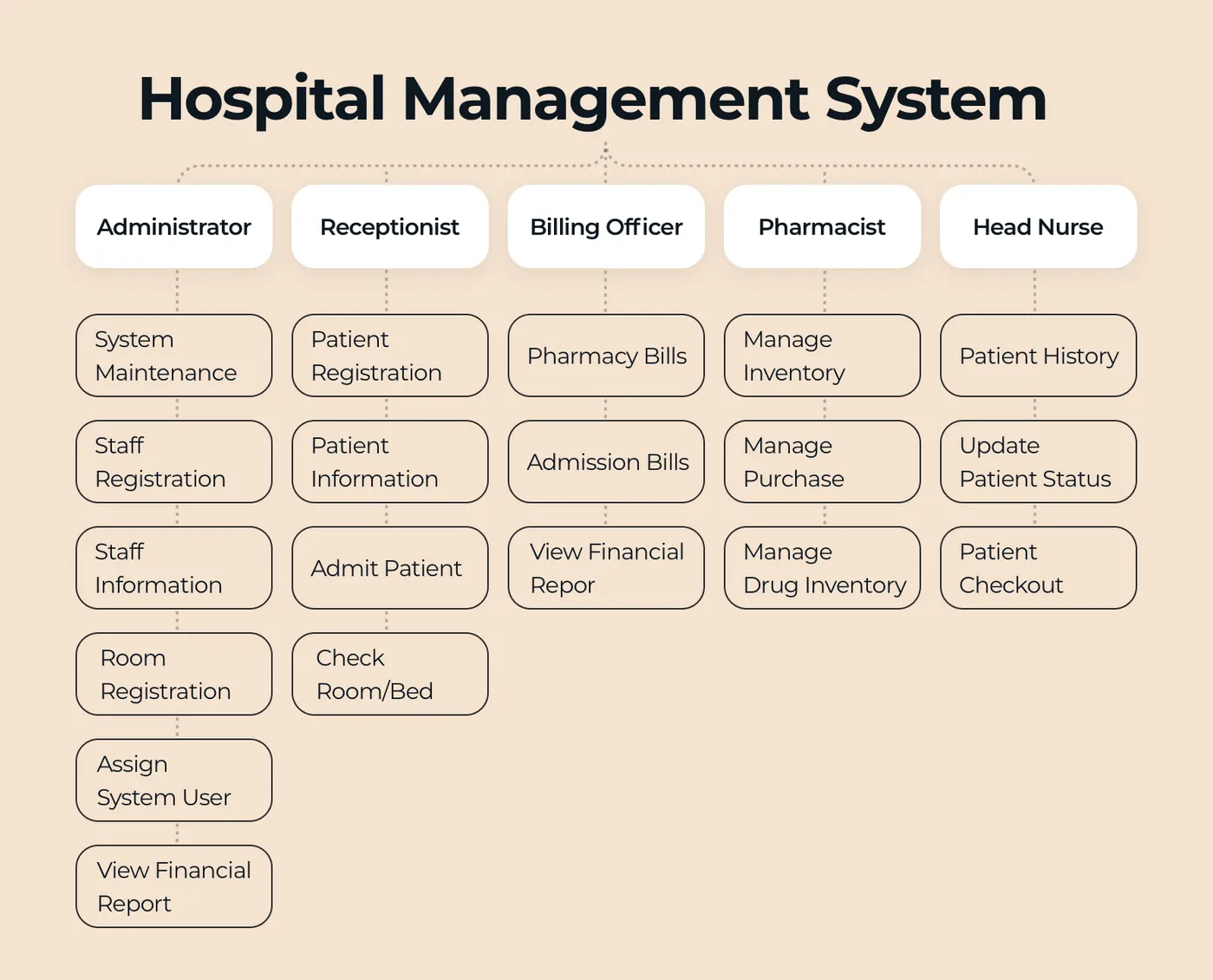
Hospital management system functional structure.
Step 3. User-friendly UI/UX Is a Must
A user-friendly interface in medical software design is a must-have feature since overloaded and complicated UI/UX design will scare away end-users.
To develop easy-to-use but at the same time informative interfaces, the medical software development companies have UX design departments. Designers work in cooperation with programmers to build a user experience that solves problems. The design includes everything related to appearance: from the color of buttons, fonts, images to animations, and pop-up notifications.
Step 4. Data Security Is a Top Priority
Since medical software collects and operates a huge amount of personal and medical data, ensuring its security is a top priority during all hospital app development processes.
Also, software that handles a huge amount of personal data must strictly adhere to data protection standards such as GDPR (Europe), CCPA (US), DPA (UK), and many others.
So make sure that the medical software development company that will build your app is experienced in data protection and can deliver top-notch data security level.
Step 5. Work Out Smooth Integration With Other Systems
Thinking over this stage is a very important step since your medical software should be painlessly integrated into a hospital’s existing workflow or other medical facilities. All existing files should remain unchanged and the process itself should not be accompanied by long downtime, as this directly affects the overall workflow of the medical facility and the quality of service.
It’s also possible that your software will complement the medical software already available in the medical institution. In this scenario, your application should sync seamlessly with other software.
Cleveroad Experience
Our development team has recently had an opportunity to work on a mood tracking app for a private practice. It’s called Nedley Scorecard and the app is currently available on iOS.
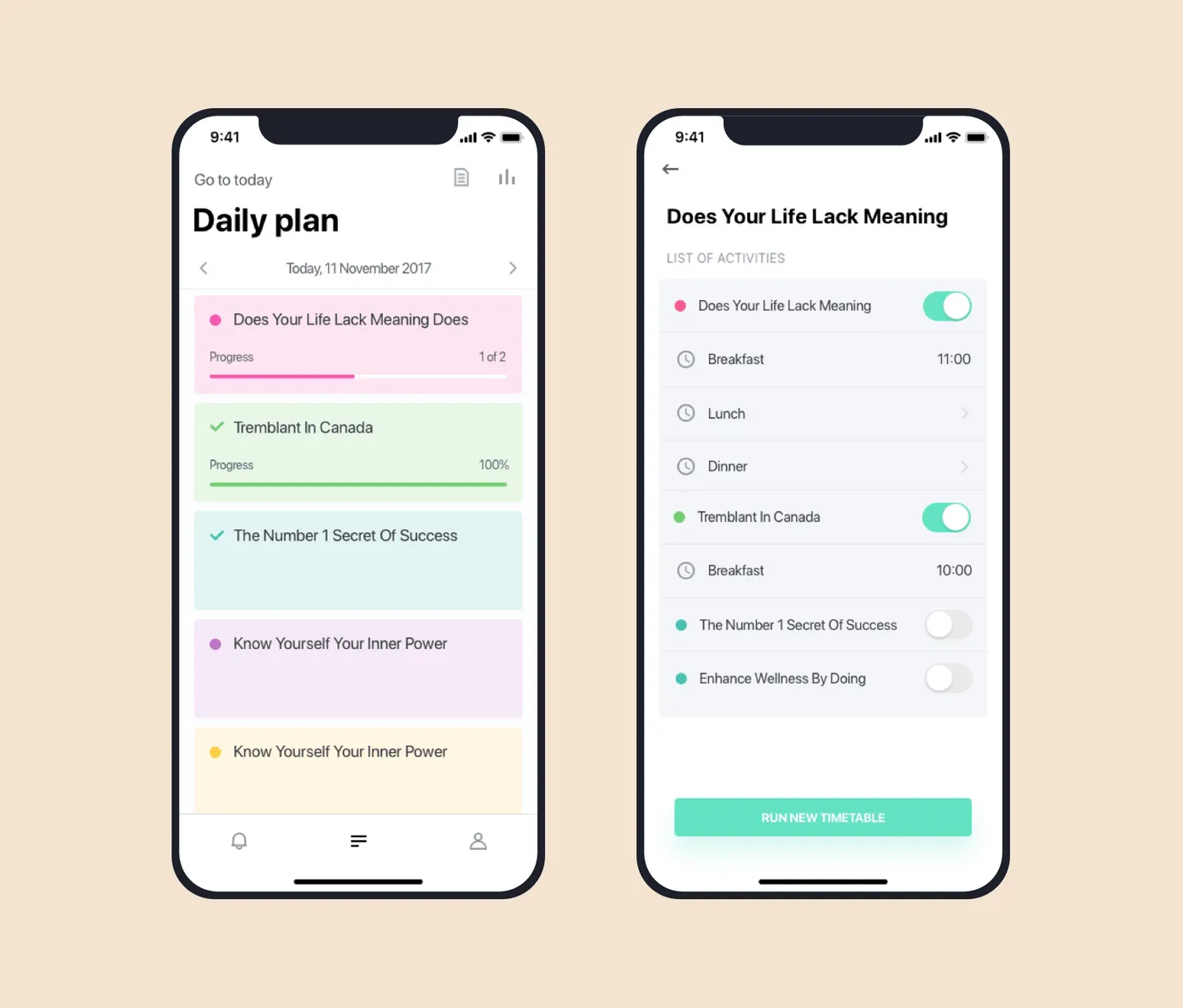
Nedley Scorecard interface
This app is based on the Nedley Depression and Anxiety Recovery Program. Patients who suffer from depression and various disorders can set different recovering activities and track their completion, improving their overall mental health.
In the picture below, you can see the tech stack used to make the Nedley Scorecard.
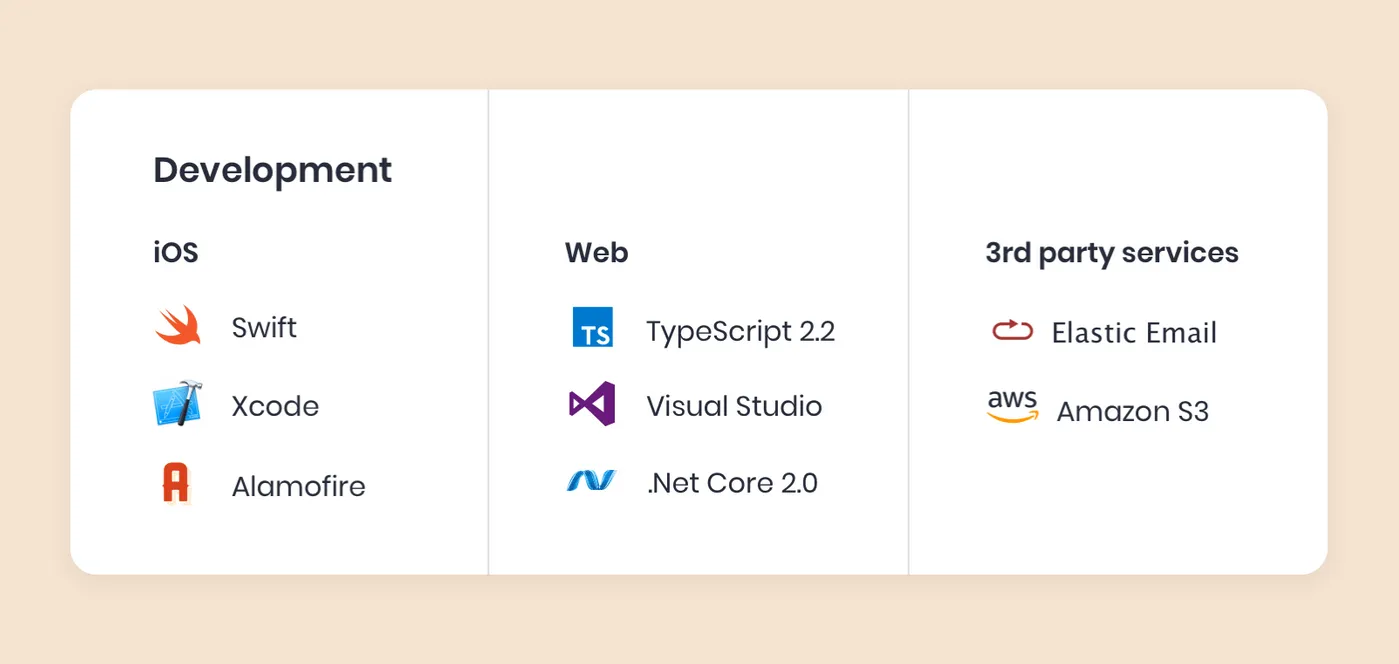
Nedley Scorecard development technologies.
Want to develop medical software?
Share your idea with us. Our experienced analysts and engineers will consult you for free.
The most commonly used medical software types are:
- EHR
- Medical database
- Medical imaging software
- Medical billing software
- E-prescribing software
- Telemedicine software
- Appointment booking software
Medical software often deals with huge amounts of user personal data and other valuable information. For this reason, every medical software must comply with data protection standards such as GDPR (Europe), CCPA (US), DPA (UK), and many others.
If you want to develop custom medical software for your business, we advise you to follow these steps:
- Step 1. Define the audience which app is aimed for
- Step 2. Work out functional structure of the app
- Step 3. User-friendly UI/UX is a must
- Step 4. Data security is a top priority
- Step 5. Work out smooth integration with other systems
According to recent researches from Statista and other reputable organizations, telemedicine is one of the fastest-growing medical software industries. Telemedicine market size will exceed $ 41 billion by 2026 that makes this area of medical software very promising.
All medical software can be divided into two categories:
- Business-centric solutions (EHRs, medical databases, imaging software and so on)
- Patient-centric solutions (e-prescribing, telemedicine software, appointment booking software and so on)
Custom medical software development lets you create unique solutions that’ll be designed for a specific medical facility, taking into account its unique workflow.
Since custom solutions fit perfectly into the hospitals’ existing workflows, such software is much more efficient and convenient than ready-made solutions.
If you want to digitize your medical facility, you can use ready-made solutions. But what should you do if the ready-made solution isn’t flexible enough and doesn’t fit the existing business? In this case, custom medical software development comes to the rescue.
But it’s worth noting that this is a rather complicated and long process. Even creating an appointment booking software will not work out of the blue. And if you plan medical device software development, it may require even more time and expertise.
Let’s get you on the right side of medical software development.

Evgeniy Altynpara is a CTO and member of the Forbes Councils’ community of tech professionals. He is an expert in software development and technological entrepreneurship and has 10+years of experience in digital transformation consulting in Healthcare, FinTech, Supply Chain and Logistics
Give us your impressions about this article
Give us your impressions about this article
Comments
4 commentsNice piece of information, you did a great job!
Recently implemented an EHR at my clinic. After a few weeks I noticed how the work efficiency had increased. The clinic staff speaks positively about this system so EHRs are the future of healthcare.
I never thought that there are so many software types for the healthcare system and that it is already so actively used. Thanks for the detailed description of each type.

This article was super interesting. Keep it up!
